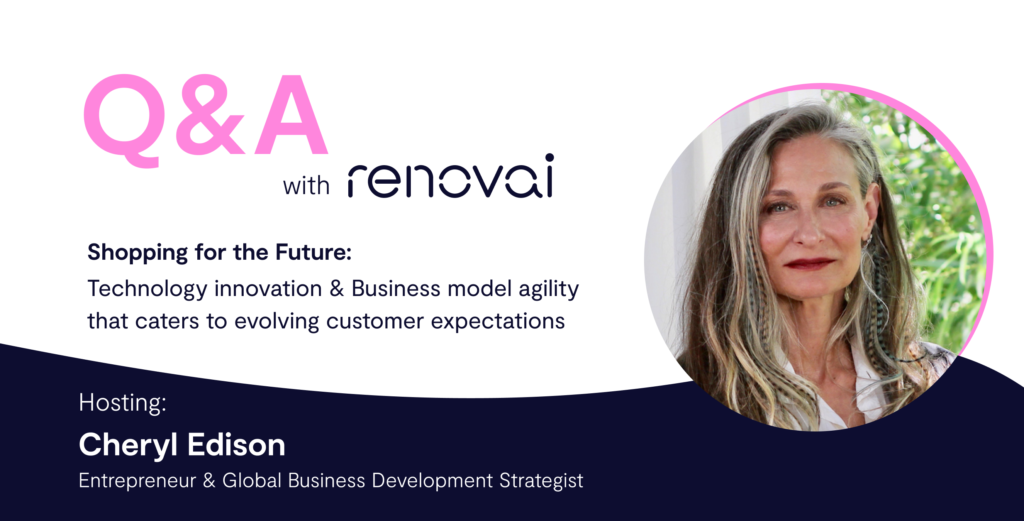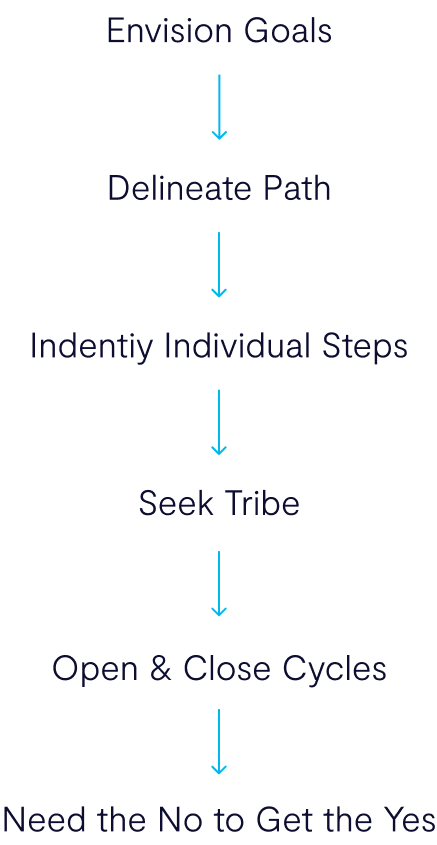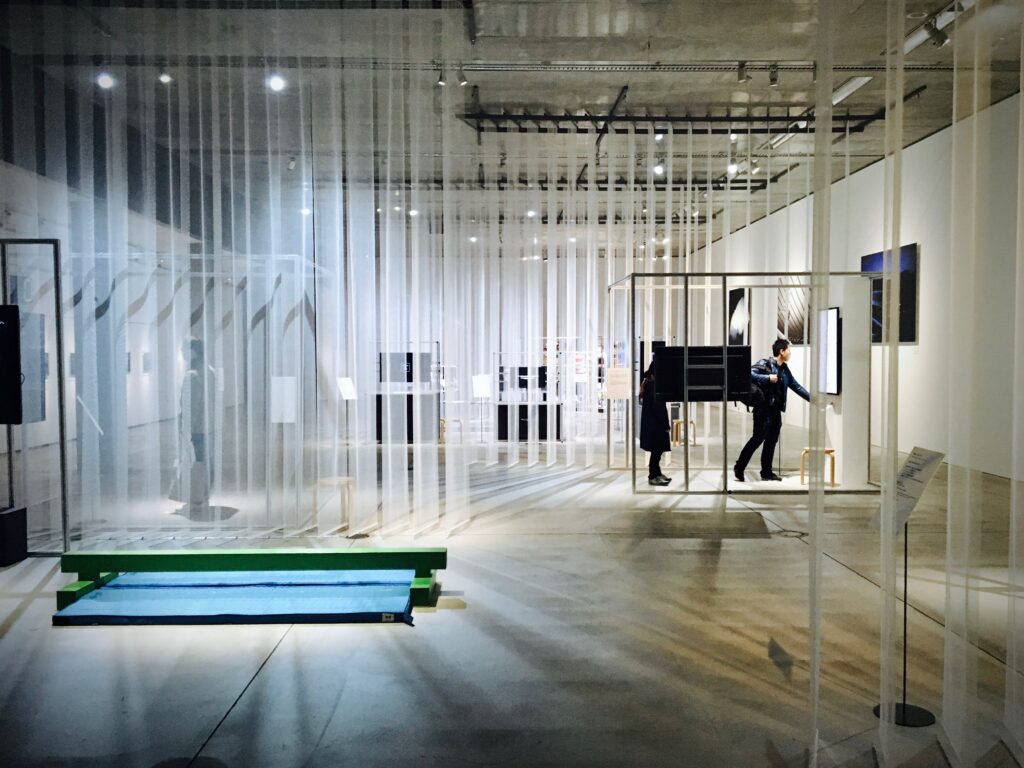Business model agility that scales to evolving customer needs

In the wake of Covid there has been a dramatic shift online which has produced both e-commerce innovation leaders and revealed others struggling to keep their relevancy Retailers and brands are continually trying to reinvent themselves, to attract customers in an omnichannel environment.
We hosted Cheryl Edison, a serial entrepreneur & global business development strategist based in San Francisco, California. Edison serves Startups, Fortune 100’s, Investors, Property Developers, Universities, Incubators/Accelerators, and Civic leaders. Her work spans 57 industries, 73 countries.
We discussed her unique growth approach, adjusting business models to support agility, the Retail Revolution and how advanced AI technologies will contribute to saving our planet.
Creativity, Community and Commerce
renovai: You wear many hats, what do you feel is your most significant mission?
Edison: My mission is to link creativity, community, and commerce. I am focused on this outcome in every conversation, in every moment of my life. Here’s my working system as I listen closely and work collaboratively towards exponentially positive outcomes:

Sometimes this work is called strategic business development, GTM, investment readiness, or simply, business growth. The focus of my work is to drive exponential economic growth. This is achieved as a function of resiliency, startup mindset, and the strategic act of pivoting to achieve business model innovation at the right time. Milestones are measured in new market traction, as key alliances and sales increase for a product or service. There is always a new opportunity emerging if we can see the pattern of the market. I tend to give a friendly nudge or two to the status quo if it is limiting growth of the company or local economy.
In every case, my core focus is to collaboratively discover what wants to happen next to increase growth. Most often I’m hired when there is a critical issue or turning point. My knack is getting teams unstuck, energized, and into action to build Creativity, meaning that spark of human innovation and expression, Community, that essential experience of belonging that makes teams and clients thrive and Commerce, the exchange of value which actively builds pathways to empathy and unites us in our humanness to embrace the biggest ideas, to live in new paradigms.
Because of Covid, we are now living the daily, moment-by-moment transition into the digital age. Online retail is the drumbeat of the transition.
The Importance of Agility – Ready to Pivot
renovai: Companies prioritize differently nowadays, what are the main pivots you encounter with your clients?
Edison: In the five-step cycle that is building and growing a business, a pivot is always step #4. When I’m hired, the pivot already has a central theme. It is the biggest challenge the company has faced to date. If not overcome, the CEO knows that the company will lag behind the competition, may even cease to exist. To the CEO, to the Founders, every pivot can feel like an existential awakening. Do or die.
The interesting thing is that there is an ah-ha somewhere in the middle of the pivot: investment readiness often becomes a business model scale-up as leaders see their opportunities through the eyes of prospective investors, a Go To Market strategy for more international sales often requires a rebrand for the new local market which can then send renewing signals back to the original national brand, just as workshops to upcycle the workforce culture to increase outputs from a new combination of in-person and remote workers often opens discovery to new options for efficiency and cost savings – of course – but can surprisingly also increase joy and loyalty in the workforce in unexpected ways as lifestyle and life purpose come together, the same is true for governance issues like diversity and inclusion for a workshop might be booked as a check-box “gotta do” which then delivers an unexpected bonus to the entire company as significant contributions start pouring in from unexpected directions.
The “See now – Buy Now” Retail Revolution
renovai: You have seen the ecosystem change many times, what is the main long-term effect you predict COVID will have on the commerce landscape?
Edison: The main effect of Covid on the commerce landscape has been to make our world smaller, more digital. Time zones, locations have begun to blur much more for more people, not just the frequent flyer community of global citizens. I predict borders are next. But let’s focus on the landscape of commerce you are specifically asking about. I’d like to talk a minute about the numbers and then I’ll give you my predictions.
The growth of e-commerce accelerated as a result of Covid-19. Anyone reading this knows that is true. Additionally, according to Digital Commerce 360, that leap in 2020 was as much as two years’ growth in one. In the USA alone online sales skyrocketed from $598 Billion USD in 2019 to $720 Billion in 2020. That’s a 32% turbo boost, breaking through all prior records. Similar trends have been shown all over the world.
And, while there have been devastating supply chain challenges due to Covid-19 that have triggered an entire series of workaround innovations, nothing stopped the e-commerce growth trend. Just a month ago, The United Nations Conference on Trade and Development published a report stating, “Global e-commerce jumps to $26.7 trillion; Covid-19 boosts online sales.” The same article went on to cite these skyrocketing statistics for gross merchandize value, “There were particularly large gains for Shopify (up 95.6%) and Walmart (72.4%).

E-commerce is now beginning to fulfill the promise first envisioned in the 90’s. Now, two decades later, many who have come of age, arriving into their buying power, were born and cut their teeth on a mobile phone, and now live in the certainty that wifi connectivity is a basic human right. The notion of setting a cell phone down to dine is the choice of very few as restaurants increasingly offer QR codes for menus. So, here we are, a motley crew, some digitally born, others wishing cell phones could just make a good call and nothing else, emerging from lockdown to explore in-person buying.
What’s happened during a lockdown? An unconscious expectation has emerged into the light we squint at the point and you-shall-receive shopping. This is a “muscle-memory” from months and months of nearly exclusive online shopping which puts an extraordinary demand on the capacity of in-store retailers to display goods and make those goods immediately available. While technology has democratized home goods, fashion, craft, and luxury bringing everything and more online, this all-things-possible dumping of options into an endless mish-mash of screens has often stymied consumers, causing some frustration. While buying overall has increased, decision-making has slowed. Why? Because there’s a learning curve to buying online and knowing what you’ll actually get when you receive the product. Some got the hang of it, while many still have not, and so find themselves cursing while hunting for the right empty box to make a return on time.
This same everything-everywhere expectation has put increasing pressure on traditional operating models to convert the ‘buzz’ from photographic displays online into cohesively branded sales offerings and potentially faster cycles of purchasing – everywhere. Shopping online has taken on a virtual reality component. Immersive. Anything is possible. And consumers want that fantasy of anything – everywhere and we want it now.
I think of this as the “See now – Buy Now” retail revolution. Visual AI-based solutions are crucial for omnichannel experiences. With them, retailers can open the doors online and in-store can provide their own end-to-end fully branded experience that welcomes and recognizes us. Being recognized warmly, accurately with empathetic offers, not just data-driven options that might work statistically, increases sales at every touchpoint because – hey – we all love being recognized and welcomed. We all want what we want, simple as that.
Empathizing Digital Interactions
renovai: What do you think should be the focus for brands nowadays when strategizing for customer loyalty?
Edison: Customer loyalty is really about connecting empathetically through the entire lifecycle. While previously thought to be only possible with one-on-one interaction human-to-human, well attuned AI is proving that human interaction with machine interfacing for certain tasks can deepen the feeling of connection and personalization at various junctures in the experience. This is a hyper-personalized anytime-anywhere experience that could only be possible with machine learning and AI.
When strategizing to avoid customer churn and increase customer loyalty, a well-executed, immersive omnichannel experience, with visual display solutions can make so much more possible, more easily. Accurate results can make or break a brand-customer relationship.
Read More About our main features:
Retail AI
Complete The Look
product recommendation engine
product matching in ecommerce
Online Merchandising

A great customer experience is not just designed for them, it is hyper-human creativity integrated into each click, each step into a store. In this new reality, a person is inspired by the recognition of their own wishes. This triggers emotions of belonging just as one feels in a community, the unique welcome made for each person automatically instills the sense of a safe purchase environment. So, there you have it again: Creativity, community, and commerce. That’s the 360 outcome of well-executed machine learning and AI. Everyone benefits across the entire value chain as the essentials of experience and product-market fit become individual experiences and joyful purchases moment-by-moment.
renovai: What are the main AI applications you feel are true game changers?
Edison: What’s next? My prediction is that AI must enter the production cycles as a fully integrated process. Knowledge-based AI will change our planet.
Let’s get real: clothing production is the #2 carbon footprint in the world, right after the oil industry. This is because of a dysfunction in the supply chain. In 2018 alone, 150 billion garments were made. 50 billion never sold at all. Another 50 billion were sold at discount. This is a $3 trillion USD industry that is basically working at a two-thirds dysfunction. I don’t care if all that discounting is somehow planned for. The 50 billion garments that never sell – that’s not a good plan.
AI is poised to be a $7.5 billion USD expenditure for retailers in 2025. Right now 75% of the spend on AI is being focused on consumer-facing experiences, but most of those are just data crunching bots. In the future, I’m expecting we will see an increase in the amount devoted to optimizing the ability to predict: what people will want to buy, how much should be produced when it should be produced, where to distribute it, and ultimately how to identify the progression of pricing.
If we can put some of that AI power into predicting buyer delight, designers and retailers will likewise enjoy creating more of what more of us want. If we prioritize that outcome, we can sustainably lower the carbon footprint of fashion, low-cost furniture, and production in all industries where personal preference and style is a key purchasing factor.
In short, advanced AI solutions provide better product-shopper matchmaking. This is mission-critical for enjoyment in our homes, at work, in public settings everywhere that include furniture, fittings, and fixtures. Accurate decision-making and purchasing is the only way to decrease unhappy purchases and the subsequent remorse of returns, carbon footprint detriment, and business loss caused by customer service tickets and shipping back and forth.
The Futuristic Omnichannel Experience
renovai: We saw a major shift in purchasing patterns because of the lockdowns and people needed to modify their living spaces – is there a way back? Are shoppers’ expectations changed for good?
Edison: Great final question. You cite two circumstances, modifying living spaces and shopper expectations. The two are both connected and independent from one another. Living spaces now more commonly include workspaces. So that old live-work-play trend is here to stay and is now seen in a myriad of adaptations both functional and dysfunctional. We are learning how to live again as farmers always have – it’s all right here and now. As such, the industries that produce the stylistic and functional options, like furniture, fittings, and fixtures have a huge opportunity to offer new uses for existing goods and new goods and services for an expanding clientele searching for what fits a new lifestyle. Clients need help making decisions never made before. AI and machine learning based on real knowledge and experience democratize successful decision-making in otherwise challenging circumstances. Advanced AI solutions make winners of shoppers buying in circumstances that can be stressful because the circumstances are new and the stakes are high. Let’s be real: no one wants to return a couch after muscling it into their living room. We all want that couch to be a dream come true!

So, yes shopper expectations are changed for good. Thankfully, there has been an acceleration in the holistic synergy between physical store experiences and online shopping. The expectation for an anytime-anywhere welcome will require innovative in-store solutions that can match the quality achieved online with AI & machine learning systems. So here we are: the omnichannel experience has officially achieved traction. Any brand without integrated customer experience systems will soon fade from view as shoppers come to rely more and more on knowledge-based AI & machine learning to guide them to discover their true preferences for purchase.
Creativity unleashed, Community welcomed, Commerce potentialized. Imagine a world of no returns? That’s the major shift we are in now. Customer experiences attuned to joyful sales. Pricing attuned to demand and accurately forecasted production. A business model cycle of success. There’s no way back – only forward – good for people, planet and profits. That’s the potential outcome we are on track to achieve using AI with machine learning in omnichannel retail.
Read More About our main features:
Product recommendation engine
Online merchandising
Product recommendation quiz
product matching in ecommerce
complete the look
